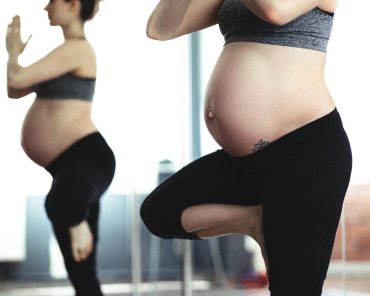
Pregnancy is a deeply transformative journey, physically, emotionally, and spiritually. It’s a time when many women turn to holistic practices like yoga to stay connected with their bodies and support their growing babies. Among the different types of yoga, Kundalini Yoga often raises questions. Its use of breathwork, movement, mantra, and meditation offers powerful benefits, but is it suitable for pregnant women?
In this blog, we explore whether you can do Kundalini Yoga when pregnant, how to approach it safely, and which practices are supportive throughout the trimesters. Whether you’re new to Kundalini or a regular practitioner, this guide will help you understand how to modify your practice to suit your changing body and needs.
Can You Do Kundalini Yoga When Pregnant? Understanding the Possibilities
So, can you do Kundalini Yoga when pregnant? The short answer is yes, with awareness, moderation, and proper guidance.
Kundalini Yoga, when practiced gently, can actually support the pregnancy experience. However, not all aspects of the practice are suitable during this time. Some kriyas (movement sequences), intense breathwork (like Kapalabhati or Bhastrika), and energy locks (bandhas) may overstimulate the nervous system or put strain on the abdominal region, which is not advised during pregnancy.
That said, Kundalini Yoga also offers many nurturing tools, like calming pranayama, mantras, and meditations, that can help ease anxiety, balance hormones, and deepen the emotional connection between mother and baby. With the right adaptations and a qualified teacher, Kundalini Yoga can be a supportive companion throughout pregnancy.
Also Read: Can You Do Kundalini Yoga on Your Period? Myths & Truths
Trimester-Wise Considerations for Kundalini Practice
Pregnancy isn’t one-size-fits-all, and neither is your yoga practice. Each trimester brings different shifts, and your Kundalini Yoga approach should honor that. Let’s break it down:
Kundalini Yoga in First Trimester of Pregnancy:
During the early weeks, your body is adjusting to hormonal changes, and fatigue is common. In this phase, it’s best to keep your Kundalini practice light and grounding. Focus on deep breathing, gentle seated movements, and short meditations. Avoid strong breath techniques or core engagement, and always listen to your body.
Kundalini YogaSecond Trimester of Pregnancy::
As energy levels often rise and the belly begins to show, this is a good time to explore more movement, just with awareness. You can include heart-opening kriyas, standing postures for stability, and soothing chants. Avoid deep twists, fast-paced sequences, or anything that compresses the belly.
Kundalini Yoga in Third Trimester of Pregnancy::
The body is now preparing for labor. This is the time for gentle, restorative practices that encourage relaxation and inner connection. Meditations that cultivate patience, breathwork that prepares you for delivery, and seated kriyas that keep the spine mobile are all ideal. Slow down and focus on grounding into your feminine strength.
Read More: Why Is Kundalini Yoga Dangerous? Truth Behind the Practice
Kundalini Yoga Practices That Can Support Pregnancy
Kundalini Yoga, when adapted properly, offers some beautiful tools to support a healthy and mindful pregnancy. Here are a few gentle elements that can become part of your prenatal routine:
Breathwork for Calm and Clarity:
Practices like long deep breathing or left-nostril breathing can help you stay centered and reduce stress. These breath patterns calm the nervous system and support emotional balance.
Safe Mantras and Meditations:
Sound vibrations like the Ra Ma Da Sa healing mantra or the Adi Shakti chant can connect you to inner strength and divine feminine energy. Meditation also helps reduce fear and builds resilience for labor and motherhood.
Gentle Movements and Heart-Opening Poses:
Seated spinal flexes, slow neck rolls, and shoulder openers can ease tension without straining the abdomen. Movements that open the chest and heart space also promote better breathing and posture as the body shifts.
These practices are not only safe but deeply supportive when done with care. They help you tune into your body’s rhythm, bond with your baby, and build emotional strength for the journey ahead.
Read More: A Complete Guide on Kundalini Yoga Teacher Training
What to Avoid in Kundalini Yoga During Pregnancy
While Kundalini Yoga can offer deep calm and spiritual nourishment, not all practices are suitable during pregnancy. It’s important to avoid anything that creates too much heat, pressure, or internal force in the body.
For example, breath techniques like breath retention (kumbhaka) or fast, forceful breathing such as Kapalabhati and Bhastrika should be avoided. These techniques can increase abdominal pressure and may cause dizziness or discomfort when you’re pregnant.
Core-activating postures, deep twists, and inverted poses like shoulder stands or headstands are also not recommended. These movements can strain your lower back or affect your balance, which naturally shifts during pregnancy.
Additionally, mulabandha (root lock) and intense energy-raising kriyas might overstimulate your nervous system. During pregnancy, your focus should shift from activating energy to grounding and supporting it.
By avoiding these elements, you create space for safe, nurturing Kundalini Yoga that works with your changing body.
Precautions and Guidance for Practicing Kundalini Yoga While Pregnant
Before you step on the mat, speak to your healthcare provider. Every pregnancy is different, and it’s important to get clearance to practice. Once you have that, try to find a Kundalini Yoga teacher who is trained in prenatal yoga. This ensures you’ll receive guidance tailored to your stage of pregnancy.
During each practice, listen to your body. If something feels too intense, skip it or modify it. You’re not practicing to push your limits, you’re practicing to support both your wellbeing and your baby’s growth.
Use props like cushions or folded blankets to support your posture. Take extra care with balance and avoid overstretching, your body is more flexible due to pregnancy hormones.
Stay hydrated, breathe deeply, and focus more on mantra chanting, meditation, and gentle movements. These are the true strengths of Kundalini Yoga during this sacred phase.
Benefits of Kundalini Yoga During Pregnancy
Practicing Kundalini Yoga during pregnancy can be incredibly enriching, both physically and emotionally. One of its greatest benefits of Kundalini Yoga is the calm it brings to your mind. Through breathwork and meditation, you learn how to manage stress, anxiety, and the emotional rollercoaster that often accompanies pregnancy.
Kundalini Yoga also helps improve your connection with your body. As your body changes, these gentle practices keep you aware and present. You feel more in tune with your baby and more trusting of your body’s natural wisdom.
Breath practices like long deep breathing prepare you for labor by strengthening your lung capacity and emotional resilience. Meanwhile, gentle stretches and kriyas reduce back pain, improve circulation, and support better sleep.
Above all, Kundalini Yoga offers a spiritual space for transformation, not just as a mother, but as a whole being stepping into a new chapter of life.
Practice Kundalini Yoga Safely with Hari Om Yoga Vidya School
At Hari Om Yoga Vidya School, we believe every stage of life deserves conscious movement, breath, and awareness, including pregnancy. Whether you’re new to Kundalini Yoga or looking to deepen your knowledge as a teacher, we offer authentic, safe, and spiritually rich programs guided by experienced mentors.
From 100-hour and 200-hour Kundalini Yoga Teacher Training to advanced 300-hour YTT, our courses blend ancient yogic wisdom with modern safety and alignment practices.
Looking for a gentle way to reconnect with your body? Our 7-day and 10-day short retreats are perfect for beginners, expecting mothers, and anyone seeking spiritual reset in a supportive, heart-centered space.
Explore the right course for you and begin your journey toward balance, awareness, and awakening, at your pace, in your way.
Conclusion
So, can you do Kundalini Yoga when pregnant? Yes, when practiced mindfully and with proper guidance, Kundalini Yoga can be a beautiful companion during pregnancy. It offers stillness in your mind, strength in your body, and a deeper spiritual connection with your growing baby.
Just remember: safety always comes first. Avoid intense or heating techniques, seek support from a prenatal-trained teacher, and give yourself permission to go slow. Kundalini Yoga is not about pushing, it’s about awakening with care, especially during this powerful time of creation.
Your pregnancy is sacred. Let your practice reflect that.



